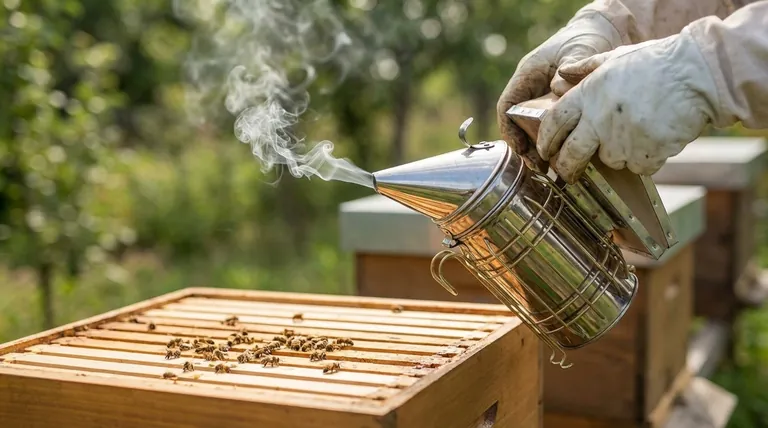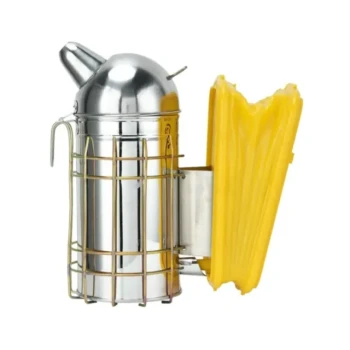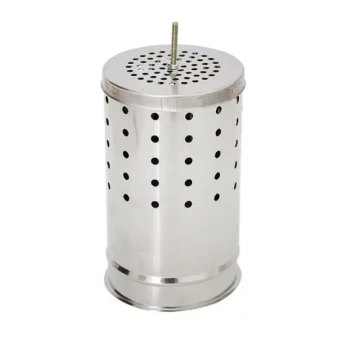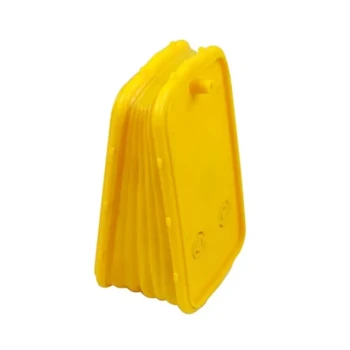When working a hive for an extended period, the correct precaution is to reapply smoke intermittently and sparingly, rather than using a large volume upfront. The goal is to use targeted, minimal puffs of smoke only when you observe the bees' initial calm behavior beginning to wane. Excessive smoke is counterproductive and will overwhelm the colony, causing more stress than it prevents.
The core principle is not about applying more smoke for a longer duration, but about applying it smarter. Think of it as a periodic re-application to maintain a calm state, using the absolute minimum necessary to achieve the desired effect.

The Principle of Minimal Effective Dose
To use a smoker correctly during long inspections, you must understand how it works and what to look for. The goal is always to use the smallest amount of smoke that keeps the hive manageable.
How Smoke Actually Works
Smoke triggers two primary responses in honeybees. First, it masks the alarm pheromones (like isoamyl acetate) that guard bees release, preventing a coordinated defensive response from spreading through the hive.
Second, it initiates a feeding instinct. The bees sense a potential fire and begin gorging on honey in case they need to abandon the hive. Bees with full stomachs are physiologically less able to bend their abdomens to sting and are generally more docile.
Reading the Bees' Behavior
Your best guide for when to add more smoke is the behavior and sound of the hive. A calm hive has a low, gentle hum.
You only need another puff of smoke if you see bees "boiling" up over the top bars of the frames, hear the pitch of the hive's hum rise sharply, or notice an increase in guard bees flying directly at your hands and face veil.
The "Set It Down" Rule
As the references suggest, it's wise to set your smoker aside while you are actively manipulating frames. Keeping it in your hand encourages unconscious, unnecessary puffing. Place it nearby on the ground in a safe spot, and only pick it up with the specific intention of applying a single, deliberate puff.
A Protocol for Extended Inspections
Follow a clear, staged approach to smoking. This ensures you are responding to the hive's needs rather than acting out of habit.
1. The Initial Application
Begin by applying one or two light puffs of cool, white smoke into the hive entrance. Wait 30-60 seconds for it to take effect. Then, crack the outer and inner covers and apply one or two more gentle puffs across the top bars before fully removing the lid.
2. During the Inspection
Proceed with your work, removing and inspecting frames. Pay close attention to the bees' behavior. For much of the inspection, you will likely not need any additional smoke.
If you observe the signs of agitation mentioned earlier, pick up your smoker. Apply a single, gentle puff across the top of the frames, wait a few moments for the bees to settle, and then resume your work.
3. Moving Between Hive Bodies
When you need to remove one hive box to inspect a lower one, the newly exposed bees may become agitated. This is a common time to reapply smoke. A single puff across the top of the lower box is usually sufficient to calm them before you proceed.
Understanding the Trade-offs of Over-Smoking
Using too much smoke is not a benign mistake; it has significant negative consequences for the colony's health and productivity.
Overwhelming the Colony
Excessive smoke is a powerful stressor. It can disorient the bees, disrupt communication, and in extreme cases, trigger absconding behavior where the colony abandons the hive entirely.
Contaminating Hive Products
Heavy, sooty smoke can easily taint the flavor of uncapped honey and permeate the beeswax. This is especially important for beekeepers who plan to harvest these products for consumption or sale.
Harming the Bees
Thick, hot smoke can physically harm the bees' delicate respiratory systems and even burn their wings. Always ensure your smoker is producing cool, white smoke, not hot black smoke or embers.
Making the Right Choice for Your Inspection
Your approach should adapt to the specific task and the temperament of the colony.
- If your primary focus is a quick check or simple task: The initial puffs at the entrance and under the lid are likely all you will need.
- If your primary focus is a deep inspection or complex manipulation (e.g., requeening): Use the standard initial application, then rely on single, targeted puffs only when you observe a clear rise in defensive behavior.
- If you are working with a known "hot" or defensive hive: You may need slightly more frequent puffs, but the principle remains the same—use the minimum amount required to keep the bees manageable, not to blast them into submission.
Effective smoking is a dialogue with your hive, not a monologue; listen to your bees, and they will tell you what they need.
Summary Table:
| Precautions for Extended Hive Smoking | Key Action |
|---|---|
| Application Method | Use intermittent, targeted puffs, not a large volume upfront. |
| Timing | Reapply only when initial calm behavior wanes (e.g., bees 'boiling' over frames). |
| Behavior Cue | Listen for a sharp rise in the hive's hum; watch for increased guard bee activity. |
| Smoker Rule | Set the smoker down between uses to avoid unconscious puffing. |
| Smoke Quality | Ensure cool, white smoke to avoid harming bees or contaminating hive products. |
Ensure your beekeeping operations are efficient and stress-free for your colonies. Proper equipment is key to applying these smoking techniques effectively. HONESTBEE supplies commercial apiaries and beekeeping equipment distributors with high-quality, reliable smokers and protective gear through our wholesale-focused operations.
Contact our team today to discuss your supply needs and learn how our products support calm, productive hive management.
Visual Guide

Related Products
- Stainless Steel Honey Bee Smoker Hive and Honeycomb Smoker for Beekeeping
- Premium Traditional Copper Bee Smoker with Bellows
- European Stainless Steel Bee Smoker for Honey Bee Hive
- Economy Galvanized Beekeeping Honey Bee Smoker for Wholesale
- Heavy Duty Manual Bee Smoker Blower for Beekeeping
People Also Ask
- What is the purpose of a bee smoker and how should it be used? A Guide to Calm, Safe Hive Inspections
- What is the proper technique for lighting a bee smoker? Master the Layered Fire Method for Calm Hives
- What is the smoke that beekeepers use? The Secret to Safe and Calm Hive Inspections
- How long does it take to clean a bee smoker? From 15-Minute Quick Fix to 10-Hour Deep Clean
- What is the primary purpose of using smoke in beekeeping? Calm Bees for Safer Hive Management



















